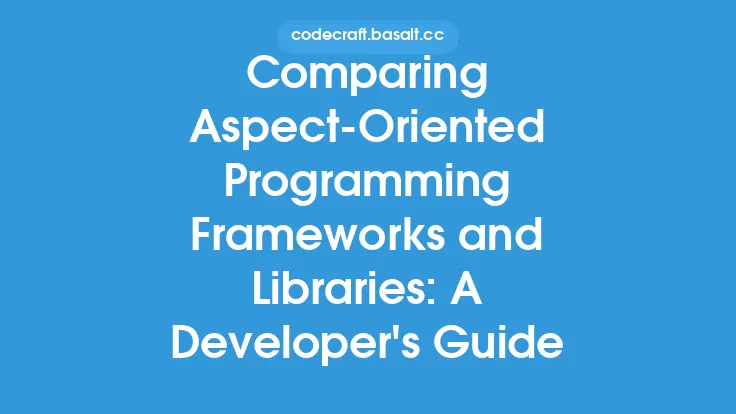Aspect-Oriented Programming (AOP) is a programming paradigm that focuses on separating cross-cutting concerns from the main logic of a program. This allows developers to modularize and reuse code more effectively, making it easier to maintain and extend. However, to ensure that AOP-based systems are robust and reliable, thorough testing is crucial. In this article, we will delve into the world of AOP and testing, exploring the concepts, techniques, and best practices that can help developers create high-quality, aspect-oriented software.
Introduction to Aspect-Oriented Testing
Aspect-Oriented Testing (AOT) is an extension of traditional testing methodologies, adapted to accommodate the unique characteristics of AOP. AOT involves testing not only the individual aspects but also their interactions and compositions. This requires a deep understanding of the aspect-oriented programming model, as well as the specific testing challenges and opportunities that it presents. By applying AOT principles and techniques, developers can ensure that their aspect-oriented systems are thoroughly validated, reliable, and maintainable.
Testing Aspect-Oriented Code
Testing aspect-oriented code involves several key activities, including unit testing, integration testing, and system testing. Unit testing focuses on individual aspects, verifying that they behave correctly in isolation. Integration testing examines how aspects interact with each other and with the core code, ensuring that the overall system functions as expected. System testing evaluates the entire system, including all aspects and their interactions, to guarantee that it meets the required functional and non-functional specifications. To perform these tests effectively, developers can leverage various testing frameworks and tools, such as JUnit, TestNG, or AspectJ.
Aspect-Oriented Testing Techniques
Several testing techniques are particularly well-suited for aspect-oriented programming, including:
- Aspect-based testing: This involves testing individual aspects in isolation, using mock objects or stubs to simulate the behavior of dependent components.
- Composition-based testing: This technique focuses on testing the interactions between aspects, verifying that they compose correctly and produce the expected results.
- Context-based testing: This approach tests aspects in different contextual scenarios, ensuring that they behave correctly under various conditions and environments.
- Property-based testing: This method involves testing aspects against specific properties or constraints, such as security, performance, or reliability requirements.
Challenges and Opportunities in Aspect-Oriented Testing
While AOT offers many benefits, it also presents several challenges and opportunities. One of the main challenges is the complexity of aspect-oriented systems, which can make it difficult to identify and isolate faults. Additionally, the dynamic and modular nature of AOP can lead to testability issues, such as aspect interference or unintended side effects. However, these challenges also create opportunities for innovation and improvement. For example, AOT can help developers identify and address cross-cutting concerns more effectively, leading to better system maintainability and reliability.
Best Practices for Aspect-Oriented Testing
To ensure the effectiveness and efficiency of AOT, developers should follow several best practices, including:
- Keep aspects simple and focused: Avoid complex aspects that are difficult to test and maintain.
- Use aspect-specific testing frameworks: Leverage testing frameworks and tools that are designed specifically for aspect-oriented programming.
- Test aspects in isolation: Verify that individual aspects behave correctly before integrating them with other components.
- Use mocking and stubbing: Employ mocking and stubbing techniques to simulate the behavior of dependent components and reduce test complexity.
- Continuously test and refine: Integrate testing into the development cycle, continuously testing and refining aspects to ensure they meet the required specifications.
Aspect-Oriented Testing Tools and Frameworks
Several testing tools and frameworks are available to support aspect-oriented testing, including:
- AspectJ: A popular aspect-oriented programming framework that provides built-in testing support.
- JUnit: A widely-used testing framework that can be used for aspect-oriented testing.
- TestNG: A testing framework that provides advanced features for aspect-oriented testing, such as support for aspect-based testing and composition-based testing.
- Eclipse AJDT: A development environment that provides integrated support for aspect-oriented programming and testing.
Conclusion
Aspect-Oriented Programming and testing are closely intertwined, and thorough testing is essential to ensure the robustness and reliability of aspect-oriented systems. By applying aspect-oriented testing techniques, following best practices, and leveraging specialized testing tools and frameworks, developers can create high-quality, maintainable, and reliable software systems. As the field of aspect-oriented programming continues to evolve, the importance of effective testing will only continue to grow, making it essential for developers to stay up-to-date with the latest techniques, tools, and methodologies.





